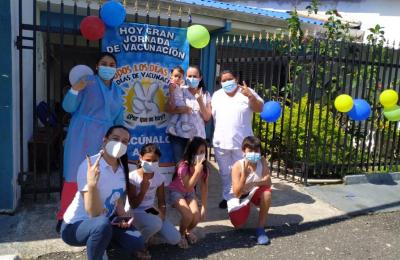Facilitators of and barriers to COVID-19 vaccination in Grenada: a qualitative study
- Read more about Facilitators of and barriers to COVID-19 vaccination in Grenada: a qualitative study
Objectives
To identify the factors contributing to coronavirus disease 2019 (COVID-19) vaccine hesitancy in Grenada.
Mapping public health training in Latin America: perspectives for training institutions
Objective
Map the public health training courses and programs offered in Latin America, and identify regional training strategies and competencies developed in health workers.
Partnering to implement the Global Initiative for Childhood Cancer in the Americas: prioritizing systems strengthening
Working with PAHO/WHO to prioritize childhood cancer in the context of systems strengthening is central to St. Jude Children's Research Hospital (SJCRH)’s role as WHO Collaborating Centre for Childhood Cancer. This manuscript focuses on how SJCRH and PAHO/WHO have partnered to apply C5 (Country Collaboration for Childhood Cancer Control) to define and implement priority actions regionally, strengthening Ministry programs for childhood cancer, while implementing the Global Initiative for Childhood Cancer since 2018.
Healthy aging and care of the older adult with chronic disease: a qualitative needs assessment in 14 eastern and southern Caribbean islands
The objectives of this qualitative needs assessment were to assess perceived needs of health and social services professionals in the Caribbean Region to enhance services supporting healthy aging and care of older adults and to assess perceived facilitators and barriers to increasing capacity to serve their aging populations. The assessment, informed by the Consolidated Framework for Implementation Science, was conducted in 14 islands in the eastern and southern Caribbean.
Estimating the economic impact of interpersonal violence in Mexico in 2021: projecting three hypothetical scenarios for 2030
Objective
To calculate the economic impact of violence across Mexico in 2021 and project costs for 2021–2030.
Methods
Incidence data was obtained from the Executive Secretariat of the National Public Security System, (SESNSP), National Population Council (CONAPO), National Institute of Statistics and Geography (INEGI), and the National Survey of Victimization and Perception of Public Safety (ENVIPE). Our model incorporates incidence estimates of the costs of events associated with violence (e.g., homicides, hospitalizations, rapes, extortions, robbery, etc).
Protecting healthcare workers during a pandemic: what can a WHO collaborating centre research partnership contribute?
Objectives
To ascertain whether and how working as a partnership of two World Health Organization collaborating centres (WHOCCs), based respectively in the Global North and Global South, can add insights on “what works to protect healthcare workers (HCWs) during a pandemic, in what contexts, using what mechanism, to achieve what outcome”.
A commentary on the Pan American Network of Nursing and Midwifery Collaborating Centres
This article provides a commentary on the Pan American Network of Nursing and Midwifery Collaborating Centres (PANMCC). The objectives are to present an overview of the formation and evolution of the network, its impact on education, research, policy and communication and the benefits of membership. The advantages of international networks as a mechanism to strengthen nursing and midwifery workforces and improve health systems are also highlighted.
CRCP units: a strategy to assess health risks in children in contaminated communities
Humanitarian crises can occur in places affected by chemical, physical, biological, and social threats, especially when these threats interact with each other and cause a syndemic. In order to avoid crises in these places, it is necessary to introduce mitigation measures that we have framed as "humanitarian scenarios". Due to their nature, implementation of these interventions requires the creation of multidisciplinary operational groups with a work strategy that integrates them into the affected community.
Detection of alcohol consumption at the first level of care in Mexico during the COVID-19 pandemic
Objective
To measure the impact of the COVID-19 pandemic on the implementation of a program for timely detection, brief intervention, and referral for treatment of alcohol consumption in health centers at the first level of care in Mexico City.












